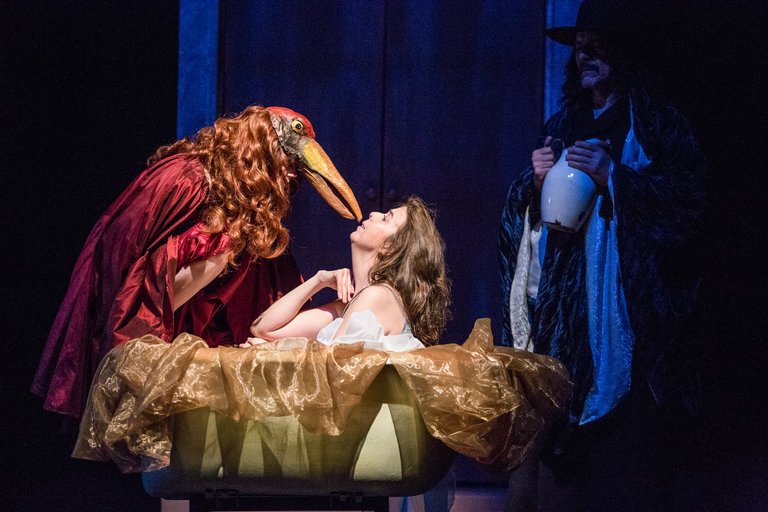Last month saw the world premier of La Maga Y El Maestro, a play about the first meeting between Leonora Carrington and Alejandro Jodoowsky. For many the latter would be the main point of interest due to his infamous Surrealist films, most notobably The Holy Mountain. And yet – the relationship between the two were of initatrix and initiand with Alejandro being in awe of Carrington mystic practices and powers — let alone her remarkable talents as a painter and having already spun a life story straight out of Apuleius.
“Leonora Carrington established herself as both a key figure in the Surrealist movement and an artist of remarkable individuality. Her biography is colorful, including a romance with the older artist Max Ernst, an escape from the Nazis during World War II, mental illness, and expatriate life in Mexico. In her art, her dreamlike, often highly detailed compositions of fantastical creatures in otherworldly settings are based on an intensely personal symbolism. The artist herself preferred not to explain this private visual language to others. However, themes of metamorphosis and magic, as well as frequent whimsy, have given her art an enduring appeal”
http://www.theartstory.org/artist-carrington-leonora.htm
The theater company’s description captures it nicely:
In Leonora and Alejandro: La Maga y El Maestro, Stacy Klein, Double Edge’s founder and artistic director, envisions a conversation between Leonora Carrington, the late British-born Mexican artist, surrealist painter, novelist and founding member of Mexico’s Women’s Liberation Movement, and Alejandro Jodorowsky, the Chilean-French filmmaker. Jodorowsky and Carrington are two artists who see the world in a similar way—they once made a play together in Mexico City, and Jodorowsky credits Carrington with introducing him to the tarot—but approach it differently. Klein notes that in the writings of both artists ‘things grow out of nothing, out of daily life,’ but, she says, ‘In Carrington’s writing, that growth is personal, intimate, while in the case of Jodorowsky, it’s always large-scale, epic.’ Leonora and Alejandro will take up themes common in Jodorowsky’s and Carrington’s work: the silencing of women, the role of military puppets and corporate thugs, and the purposeful devastation of land, water and people. ”
https://doubleedgetheatre.org/leonora-and-alejandro/
The New York Times dug it:
“Conceived and directed by Stacy Klein, “Leonora and Alejandro” draws from its two subjects’ art and writings, including their stories, novels and memoirs. But the border between reality and dream, conscious and unconscious was porous for them — indeed, that ambiguity is one of the foundational elements of Surrealism, a style with which they are commonly associated. And so it is hard to judge the reliability of the memoir “The Spiritual Journey of Alejandro Jodorowsky,” from which the meet-cute details come from. Did Carrington (the sensational Jennifer Johnson) really draw blood from her thigh, pour it in a cup and gave to it Jodorowsky to drink? It’s best to just go with the flow.”
https://www.nytimes.com/2018/03/19/theater/leonora-and-alejandro-review-montclair-university.html.
A few years ago Matthew Levi Stevens posted a fascinating essay regarding Jodorowsky’s relationship with Carrington. A very powerful part of this essay is a quotation of an invocation by Carrington that Jodorowsky recounts — which could have been made up by him. Reportedly he showed up at her house in the middle of the night and found her seated in a wooden throne, naked except for a Jewish prayer shawl and as he entered her presence, she spoke these words.
“I, the eye that sees nine different worlds and tells the tale of each.
I, Anuba who saw the guts of the pharaoh, embalmer, outcast.
I, the lion goddess who ate the ancestors and churned them to gold in her belly.
I, the lunatic and fool, meat for worse fools than I.
I, the bitch of Sirius, landed here from the terrible hyperbole to howl at the moon.
I, the bamboo in the hand of Huang Po.
I, the queen bee in the entrails of Samson’s dead lion.
I, the tears of the archangel that melted it again.
I, the solitary joke made by the snow queen in higher mathematics.
I, the gypsy who brought the first greasy tarot from Venus.
I, the tree of wisdom whose thirteen branches lead eternally back again.
I, the eleventh commandment: Thou shalt despise no being.”
Read the entire essay here:
https://whollybooks.wordpress.com/2014/09/30/jodorowsky-meets-leonora/


